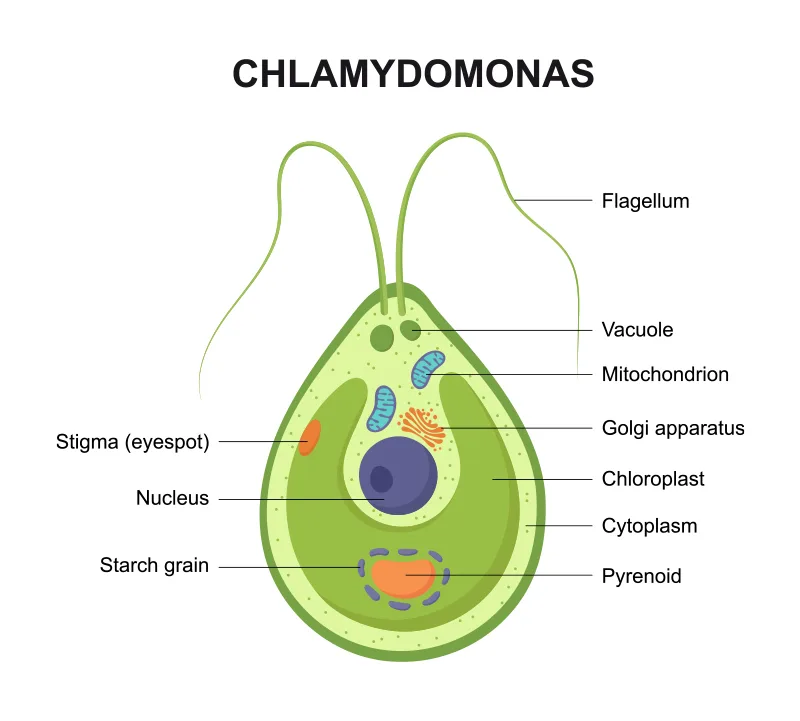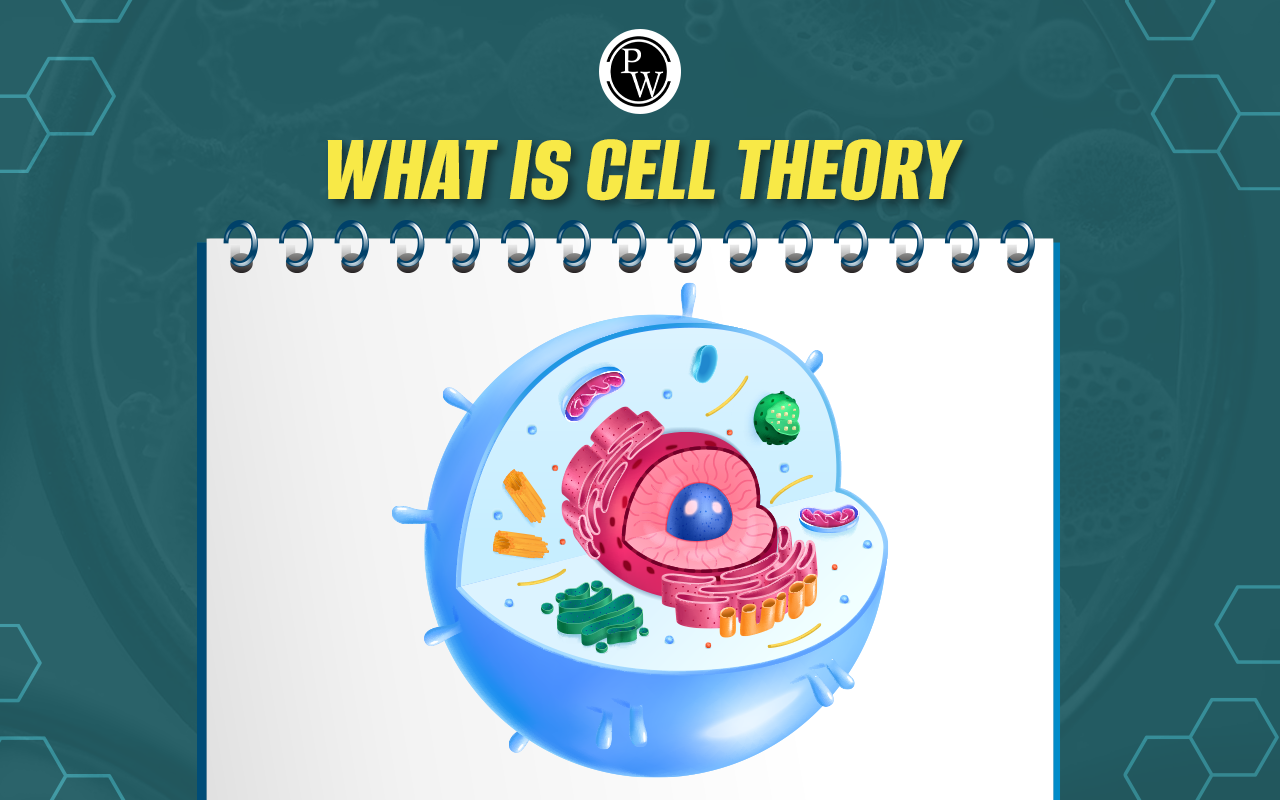
Chlamydomonas: Chlamydomonas is a group of green algae that includes approximately 150 types of single-celled organisms with flagella. They can be found in stagnant water, damp soil, freshwater, seawater, and even snow, known as "snow algae." Chlamydomonas is widely studied in molecular biology as a model organism, particularly for studies on flagellar movement, chloroplast behaviour, formation, and genetics.
Chlamydomonas has light-sensitive ion channels called channelrhodopsins that are activated directly by light. Some Chlamydomonas regulatory mechanisms are more complex than those found in gymnosperms, with related regulatory proteins being larger and containing extra domains. Molecular phylogeny studies have revealed that the traditional morphological classification of Chlamydomonas is polyphyletic within the order Volvocales. As a result, many species have been reclassified (for example, Oogamochlamys and Lobochlamys), and numerous lineages within the broader classification of "Chlamydomonas" need to be reevaluated. The article gives a detailed overview of Chlamydomonas, including its structure, classification, characteristics, species diversity, reproduction, and life cycle.Pre Fertilisation: Structures and Events
What is Chlamydomonas?
Microorganisms are tiny living things that are invisible to the naked eye and must be observed with specialized equipment. These algae are typically found in soil, ponds, and ditches. Some Chlamydomonas species reproduce quickly, turning bodies of water green. One particular species, C. nivalis, contains a red pigment called hematochrome, which can turn melting snow red. The cells of most Chlamydomonas species are oval-shaped and contain a noncellulosic membrane (theca), an eyespot (stigma), and a cup-shaped chloroplast for photosynthesis. While these organisms primarily undergo photosynthesis, they can also absorb nutrients through their cell surface. Reproduction in Chlamydomonas occurs asexually through zoospores and sexually through gamete formation. The processes of motility, sexual differentiation, and gamete fusion in Chlamydomonas appear to be influenced by the production of regulatory substances, such as termones and gamones, which act similarly to hormones.Chlamydomonas Diagram
The following is the diagram of Chlamydomonas:
Chlamydomonas Classification
Chlamydomonas belongs to the Plantae kingdom, Chlorophyta division, Chlorophyceae class, Chlamydomonadales order, and Chlamydomonadaceae family. Classification of Chlamydomonas:| Chlamydomonas Classification | |
|---|---|
| Chlamydomonas Kingdom | Plantae |
| Chlamydomonas Division | Chlorophyta |
| Chlamydomonas Class | Chlorophyceae |
| Chlamydomonas Order | Chlamydomonadales |
| Chlamydomonas Family | Chlamydomonadaceae |
| Chlamydomonas Genus | Chlamydomonas |
Chlamydomonas Species
The following Chlamydomonas species are classified as:- Chlamydomonas acidophila
- Chlamydomonas caudata Wille
- Chlamydomonas moewusii
- Chlamydomonas nivalis
- Chlamydomonas ovoidae
- Chlamydomonas reinhardtii
Chlamydomonas Structure
Chlamydomonas is a type of single-celled green algae found in various aquatic environments. These microorganisms have a pear-shaped body and can be found in freshwater, saltwater, stagnant water, and moist soil. Key structures of Chlamydomonas include: Cell wall: A thin, rigid wall made of cellulose that surrounds and protects the cell. Cytoplasm: The gel-like substance inside the cell wall where most cellular activities occur. It contains organelles such as mitochondria, ribosomes, and endoplasmic reticulum. Nucleus: Located within the cup-shaped chloroplast, it contains the organism's genetic material. Chloroplast: The primary organelle responsible for photosynthesis. It has a cup-shaped structure containing chlorophyll, which gives Chlamydomonas its green color. The chloroplast also contains a pyrenoid, which stores starch. Flagella: Chlamydomonas has two whip-like flagella at its front end, which help it move in water. Contractile vacuoles: Vacuoles near the base of each flagellum that regulate the cell's water balance by expelling excess water. Eyespot (stigma): A red-colored spot near the base of the flagella that helps Chlamydomonas sense light direction for optimal photosynthesis. Chlamydomonas varies in size depending on the species but is typically very small, ranging from 20 to 30 micrometers in length and diameter.Chlamydomonas Characteristics
Chlamydomonas belongs to a group of single-celled, green algae that have two flagella, enabling them to move. They are typically found in freshwater or moist soil and are too small to be seen without a microscope. However, in large numbers, they can turn ponds and ditches green. Here are some key characteristics of Chlamydomonas: Structure: Most Chlamydomonas species have a pear-shaped or oval cell body. Movement: They are motile, thanks to their two flagella, which also help them feed and avoid predators. Cell Wall: Unlike many other algae, Chlamydomonas have a thin cell wall composed of glycoprotein and non-cellulosic polysaccharides, not cellulose. Chloroplast: Each cell contains a single, cup-shaped chloroplast responsible for photosynthesis. Eyespot: Chlamydomonas have a red eyespot, or stigma, which helps them sense light direction, aiding in their movement towards sunlight for optimal photosynthesis. Nucleus: The nucleus is typically located within the chloroplast's cavity. Reproduction: Chlamydomonas reproduce both sexually and asexually. Asexual reproduction involves the formation of zoospores, while sexual reproduction can occur through isogamy (similar gametes), anisogamy (dissimilar gametes), or oogamy (large non-motile egg and small motile sperm). Due to its ease of cultivation in laboratory conditions, Chlamydomonas is a popular organism for scientific study. It is particularly valuable for research on photosynthesis, flagellar motility, and cell signaling. Additionally, Chlamydomonas plays a crucial role as a primary producer in aquatic environments.Chlamydomonas Reproduction
Chlamydomonas, a unicellular green algae, reproduces through both sexual and asexual methods.Asexual Reproduction
Asexual reproduction in Chlamydomonas involves the following types: Zoospore Formation: The most common form of asexual reproduction in Chlamydomonas. The parent cell divides its nucleus and chloroplast through mitosis. The cytoplasm then divides, producing two or four zoospores, which are mobile offspring with flagella. These zoospores are released from the parent cell wall and grow into new Chlamydomonas organisms. Aplanospores: Under adverse conditions, Chlamydomonas can reproduce asexually by producing aplanospores. These are inactive spores with thick cell walls that enable them to survive harsh conditions. When conditions improve, aplanospores can sprout and develop into new flagellated Chlamydomonas cells. Palmella Stage: In this form of asexual reproduction, Chlamydomonas cells divide within their cell wall but do not separate. This leads to a cluster of inactive cells surrounded by a common gelatinous substance. The substance helps retain water and provides some protection against predators. When conditions become favourable, the cells can grow flagella and emerge as zoospores.| Other NEET Biology Topics | ||
|---|---|---|
| Ribosomes | Pollination | Apomixis |
| Centrosome | Embryo | Tissues |
Sexual Reproduction
Sexual reproduction in Chlamydomonas involves the fusion of gametes and can occur in three ways: Isogamy: The most common type of sexual reproduction in Chlamydomonas, where two similar flagellated gametes (isogametes) from different individuals fuse to form a zygote. The zygote develops a thick wall and undergoes meiosis, resulting in four haploid zoospores that can sprout into new Chlamydomonas organisms. Anisogamy: In anisogamy, two dissimilar gametes (anisogametes) fuse to form a zygote. Typically, one gamete is larger and non-motile (female gamete), while the other is smaller and motile (male gamete). Oogamy: A type of anisogamy where the female gamete is significantly larger than the male gamete. Oogamy is a rare form of sexual reproduction in Chlamydomonas. Environmental factors such as nutrient availability and light intensity can influence the type of sexual reproduction in Chlamydomonas. Sexual reproduction introduces genetic variability in offspring, which can be advantageous for adapting to changing environments.Chlamydomonas Life Cycle
Chlamydomonas, a single-celled green alga, uses both asexual and sexual reproduction methods.Asexual Reproduction in Chlamydomonas Life Cycle
During asexual reproduction, a single Chlamydomonas parent cell divides through mitosis to create genetically identical daughter cells. This process is known as zoospore formation and involves several steps:- Mitosis: The parent cell's nucleus divides, forming two daughter nuclei.
- Cytokinesis: The cytoplasm divides the daughter nuclei into two new cells.
- Zoospore Formation: Each daughter cell develops a cell wall and two flagella, becoming a motile zoospore.
- Release: Zoospores are released from the parent cell wall and grow into individual Chlamydomonas cells.
Sexual Reproduction in Chlamydomonas Life Cycle
Sexual reproduction in Chlamydomonas involves the fusion of gametes from different mating types to produce a zygote. The typical sexual life cycle includes:- Gametogenesis: During unfavorable conditions, mature Chlamydomonas cells undergo meiosis to produce non-motile gametes (usually four or eight per cell). These gametes are typically similar in size and shape (isogametes).
- Gamete Release: Gametes are released from the parent cell wall.
- Swarming: Chemical signals called gamones attract gametes of the opposite mating type, causing them to swarm together.
- Gamete Fusion: Compatible gametes fuse to form a diploid zygote.
- Zygospore Formation: The zygote develops a thick, resistant wall called a zygospore, allowing it to survive harsh conditions.
- Meiosis and Germination: When conditions improve, the zygospore undergoes meiosis, producing four haploid zoospores. These zoospores germinate into new Chlamydomonas individuals.
Chlamydomonas Unicellular Or Multicellular
Chlamydomonas is a single-celled green alga, indicating that it comprises just one cell responsible for all life-sustaining processes. Notably, Chlamydomonas falls under the category of volvocine algae, encompassing both single-celled and multicellular organisms. Its relative, Volvox, is a multicellular alga forming colonies of around 50,000 cells [see image of Volvox algae]. The study of Chlamydomonas and Volvox aids scientists in comprehending the evolution of multicellular life forms.| NEET Exam Important Links | |
|---|---|
| NEET Syllabus | NEET Biology Diagrams |
| NEET Biology MCQ | NEET Biology Chapter wise Weightage |
| NEET Biology Notes | NEET Previous Year Question papers |
Chlamydomonas FAQs
Is Chlamydomonas a type of algae?
Chlamydomonas is a unicellular organism classified in the Chlorophyta group, known as green algae.
What is Chlamydomonas according to Class 11?
Chlamydomonas is a simple, unicellular, and motile freshwater alga, exhibiting oval, spherical, or pyriform shapes. It is enveloped by a thin and firm cellulose cell wall, with the cytoplasm situated between the cell membrane and the chloroplast.
What are the characteristics of Chlamydomonas?
The prominent features of Chlamydomonas include its pyriform shape, possession of a cup-shaped chloroplast, and a photoreceptive eyespot located at the chloroplast.
Is Chlamydomonas the same as Volvox?
Chlamydomonas is unicellular, representing the ancestral form of the group, while Volvox is multicellular, having evolved several innovations such as germ-soma differentiation, sexual dimorphism, and complex morphogenetic patterning.
Is Chlamydomonas classified as blue-green algae?
Chlamydomonas belongs to the genus of unicellular green algae (Chlorophyta) and is not classified as blue-green algae.
Who discovered Chlamydomonas?
The genus Chlamydomonas was described by Ehrenberg in 1833, with the species C. reinhardtii being identified by Dangeard in 1888 (Harris et al., 2009).
🔥 Trending Blogs
Talk to a counsellorHave doubts? Our support team will be happy to assist you!

Check out these Related Articles
Free Learning Resources
PW Books
Notes (Class 10-12)
PW Study Materials
Notes (Class 6-9)
Ncert Solutions
Govt Exams
Class 6th to 12th Online Courses
Govt Job Exams Courses
UPSC Coaching
Defence Exam Coaching
Gate Exam Coaching
Other Exams
Know about Physics Wallah
Physics Wallah is an Indian edtech platform that provides accessible & comprehensive learning experiences to students from Class 6th to postgraduate level. We also provide extensive NCERT solutions, sample paper, NEET, JEE Mains, BITSAT previous year papers & more such resources to students. Physics Wallah also caters to over 3.5 million registered students and over 78 lakh+ Youtube subscribers with 4.8 rating on its app.
We Stand Out because
We provide students with intensive courses with India’s qualified & experienced faculties & mentors. PW strives to make the learning experience comprehensive and accessible for students of all sections of society. We believe in empowering every single student who couldn't dream of a good career in engineering and medical field earlier.
Our Key Focus Areas
Physics Wallah's main focus is to make the learning experience as economical as possible for all students. With our affordable courses like Lakshya, Udaan and Arjuna and many others, we have been able to provide a platform for lakhs of aspirants. From providing Chemistry, Maths, Physics formula to giving e-books of eminent authors like RD Sharma, RS Aggarwal and Lakhmir Singh, PW focuses on every single student's need for preparation.
What Makes Us Different
Physics Wallah strives to develop a comprehensive pedagogical structure for students, where they get a state-of-the-art learning experience with study material and resources. Apart from catering students preparing for JEE Mains and NEET, PW also provides study material for each state board like Uttar Pradesh, Bihar, and others
Copyright © 2025 Physicswallah Limited All rights reserved.
Get App









